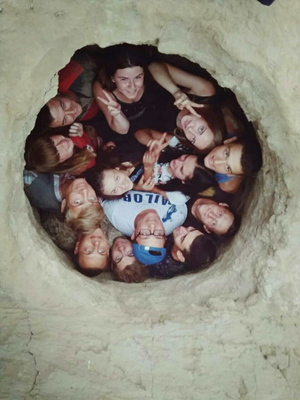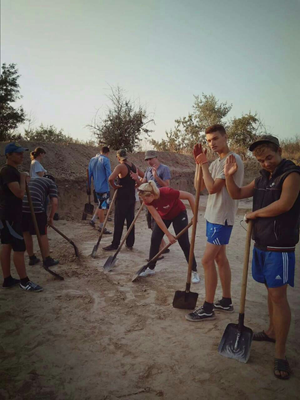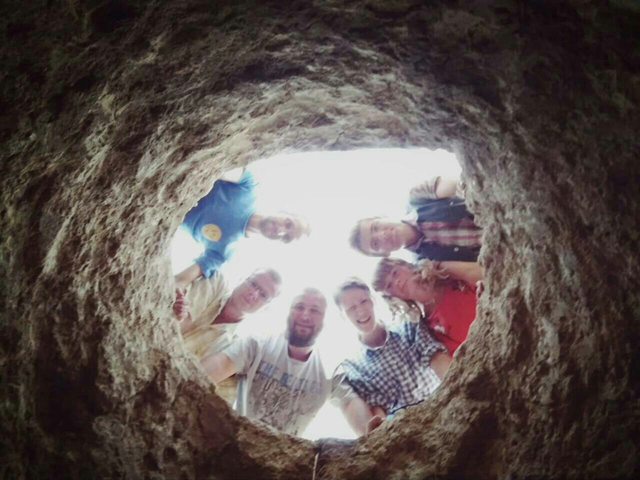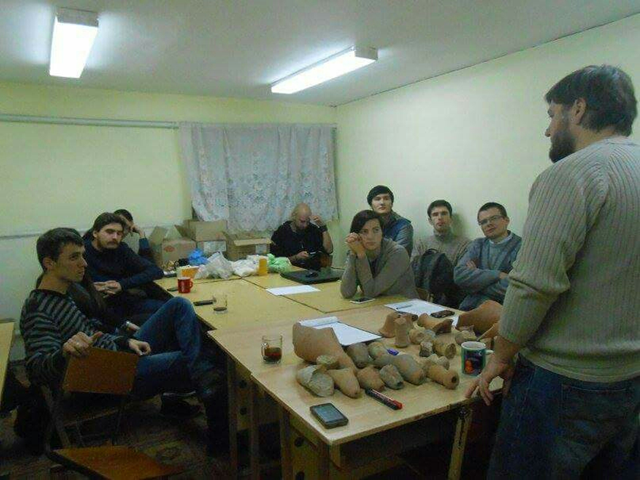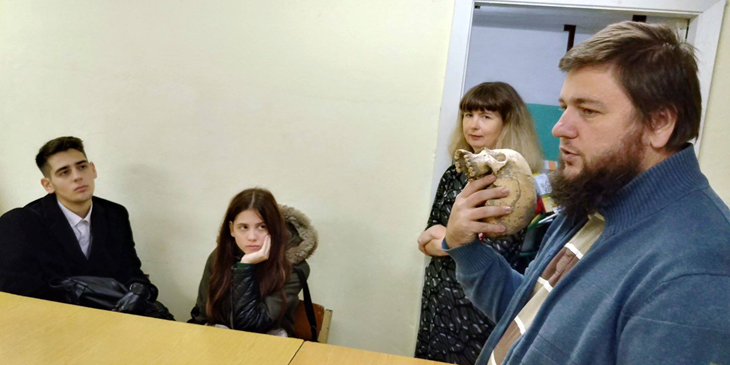Updated: 5/20/2025
On the basis of the decision of the academic council of the Kherson State University (protocol dated 04/27/2020 No. 10) and the rector's order dated 05/04/2020 No. 403-D, the Regulations on the Archaeological Museum of Kherson State University have been put into effect. According to the rector's order dated 10.12.2020 No. 968 - D "On changes in the structure of Kherson State University" from 10.12.2020, the archaeological museum of the Kherson State University will be created as a separate structural unit, subordinating it to the first vice-rector S.A. Omelchuk. Serhiy Nemtsev, a specialist of the 1st category, has been appointed the head of the archeological fly of the KSU.


.jpg?id=be4ecdba-4be8-4fea-b83b-bb0bb49282a4&width=300&height=640)

Instructions for the organization of accounting of museum objects of the Archaeological Museum of the KSU
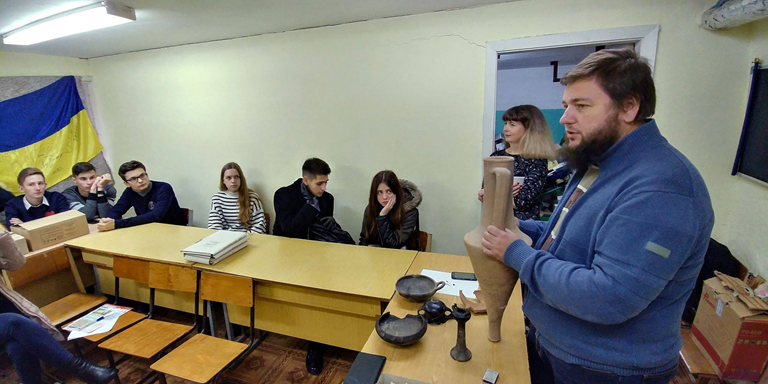
Everyone remembers their first impressions of meeting the historical past of mankind in history lessons at school. The study of world history begins with an acquaintance with primitive society, the mysteries of ancient Egypt and the Middle East, the sophistication of ancient Greece, the grandeur of ancient Rome. Students listen with delight to stories about the construction of the Egyptian pyramids and the process of their study, view the masterpieces of ancient Greek sculpture and architecture, follow the expansion of the Roman Empire. At the same time, the teacher emphasizes that the study of particularly distant from modern historical epochs is impossible without the involvement of various sources of information. Especially when written sources do not sufficiently or do not reflect the period covered. Therefore, the most informative in the historical reconstruction of such periods are material sources, and the archaeologist comes to the fore.
Archaeological excavations, which attract with their unusualness, a certain mystery, give results that could not be obtained by the usual study of written sources. An archaeologist, who to the average person always seems to be a man with a shovel and shards, is in fact not only a historian with a specific field of activity, but also a bit of a geologist, anthropologist, zoologist, ceramist, restorer, chemist, photographer, artist. This makes it possible, with the help of data obtained by archaeologists, to most fully and, most importantly, objectively reproduce the historical past.
Therefore, the process of professional training of future historians is impossible without mastering the theoretical course "Archeology" and students of historical specialties of archaeological practice.
Thus, they receive the necessary knowledge and skills in further professional activities, as well as unforgettable impressions of contact with antiquity in its immediate remains.
The educational process at Kherson State University in accordance with the training programs for professional historians also involves students of history courses of theoretical courses "Archeology" and "Archeology of Ukraine" and their archaeological practice. Since 1997, under the leadership of Candidate of Historical Sciences, Associate Professor of World History and Historiography Bilkova Valeria Pavlovna, students have undergone an internship that acquired the official status of KSU archaeological expedition in 2005. This expedition studies Belozersky settlement (Dniprovske village, Belozersky district). systematically studied by Valeria Pavlivna since 1989. In accordance with the existing regulations, archeological excavations are carried out according to the Open Letter issued by the Field Committee of the Institute of Archeology of the NAS of Ukraine and permission to excavate the Department of Cultural Heritage of the Ministry of Culture and Tourism of Ukraine.
The first exploration work was carried out in the 80's of the XIX century. GL Skadovsky, who gave the settlement the name Belozerske gorodishche. From 1989 to 2007 the excavations were conducted under the direction of Bilkova VP During this time, 4 excavations were laid, with a total area of 3,000 square meters. As a result of these studies, it was determined that the settlement was founded in the early IV century. B.C. and ceased to exist in the first quarter of the third century. B.C. The culture of this settlement coincides with the materials found on the monuments of the agricultural territory of Olbia. This allows us to include our monument in this group. Presumably, Belozerskoye settlement was the final eastern point of the rural district of Olbia at this time. Later, the Sarmatians came to this territory, whose burials were allowed into the cultural layer. In the Middle Ages, the Polovtsian tribes also lived here. Their burials and some items were found. The study of the monument provides important material for tracing the economic, socio-cultural and ethnic history of the Northern Black Sea coast and its relations with Greater Greece and Asia Minor.
In 2007, work was carried out jointly with the Regional Inspectorate for the Protection of Historical and Cultural Monuments at the Novozburievsky settlement of the Bronze Age (Holoprystan district, Kherson region). The settlement was opened by A. Yakubenko, a graduate of the KSU Faculty of History.
The further process of processing and storage of archeological collections raised the question of the need to create a Research Archaeological Laboratory within the former historical faculty, headed by VP Bilkova. The laboratory has existed since 2001. Its operation has created favorable conditions, primarily for the educational process. The laboratory conducts laboratory work for full-time and part-time historians, during which they work with archaeological collections, acquiring skills in identifying and analyzing artifacts. Classes are held separately, which give students the opportunity to learn the skills of in-house processing of materials (cleaning, encryption, reconstruction). They also have the opportunity to use archaeological collections in the Museology course and during pedagogical practice at school, diversifying the rather dry presentation of school history textbooks. Archaeological expedition, its preparation and conduct is a priority of the laboratory. For students of history, this is primarily a time to apply in practice the theoretical knowledge that they received at the university in lectures, seminars and laboratories. They have the opportunity for direct practical acquaintance and take part in archeological excavations, find and process the found material. However, archaeological practice does not limit students to only these types of work. Students can also get acquainted with other types of excavations during excursions to the Olbia Archaeological Reserve and the Berezan Archaeological Expedition (Berezan Island). And students spend any time at the excavations on recreation, various sports and entertainment events, excursions to the enterprises of Belozersky district (sturgeon factory ...). Therefore, the internship remains for students one of the most memorable and interesting types of educational work at the university.
Another type of work of the laboratory is direct research work, during which the materials of the last field season are processed and studied, and as a result - writing an annual scientific report on excavations at Belozersky settlement, participation in national and international scientific conferences on archeology of the Northern Black Sea region. coverage of excavation results in scientific publications.
Within the framework of this direction of the laboratory's work, a problem group of students-historians led by VP Bilkova worked in it, in which they dealt with the problems of archeology, history of Ancient Greece and Ancient Rome, epigraphy, numismatics. They also used in writing course, diploma and master's research materials obtained from archaeological excavations of Belozersky settlement. Developing and deepening their interest in archeology, students who worked in this problem group, had the opportunity in further professional activities to directly engage in their favorite business, not only working in archaeological expeditions of Ukraine. Thus, Andriy Yakubenko, a 2004 graduate of the History Department of Kherson State University, works in the Department of Archeology of the Kherson Regional Inspectorate for the Protection of Historical and Cultural Monuments.
In 2019, the KSU archeological expedition started its activity at the Skelka settlement near the village of Oleksandrivka, Belozersky district.
Thus, the presence of the Archaeological Laboratory and a working Archaeological Expedition allows future students interested in history and archeology to realize their interest not only in the theoretical aspect, but, above all, in its practical aspect.
We will be glad to see among the students of Kherson State University all for whom studying archeology is a dream that can come true.
Archaeological photo gallery
